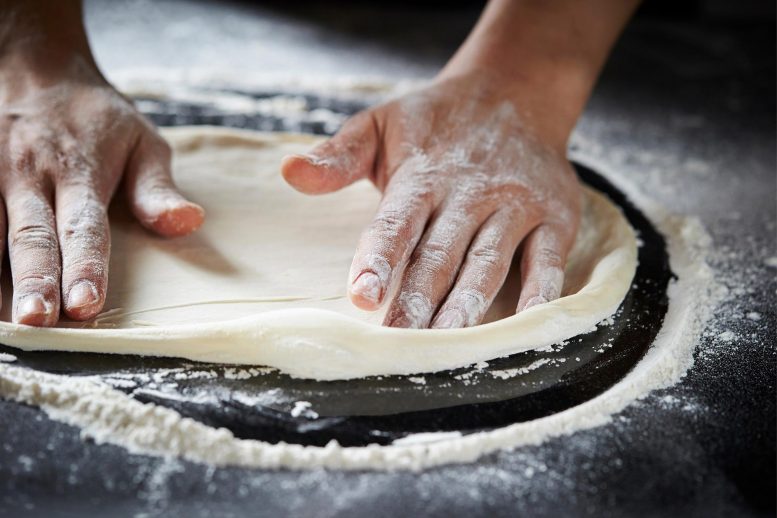
Kneading pizza dough
Dissolving gas into dough at high pressures can create ideal rise without yeast.
In typical breads, yeast produces bubbles via a biochemical process, causing dough to rise and develop into light, airy, and tasty treats. Without that yeast, it is difficult to make morsels with the same characteristic taste and texture. The perfect, yeast-free pizza, as such a food, presents an important challenge for bakers and yeast-intolerant crust enthusiasts across the globe.
In Physics of Fluids, by AIP Publishing, researchers from the University of Naples Federico II developed a method to leaven pizza dough without yeast.
The team, which included its very own professional pizza-maker/graduate student, prepared the dough by mixing water, flour, and salt and placing it in a hot autoclave, an industrial device designed to raise temperature and pressure.
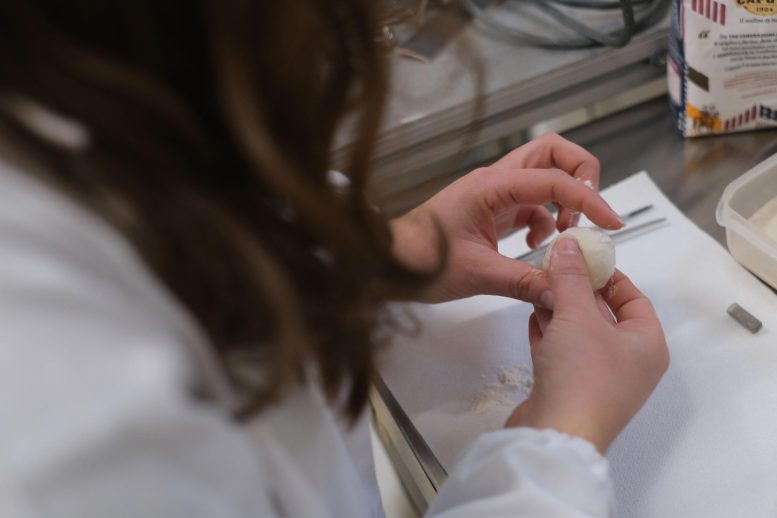
The researchers used small pieces of dough to test the rise with and without yeast. Credit: Francesco Paolo Desiderio
From there, the process is like the one used to produce carbonation in soda. Gas is dissolved into the dough at high pressure, and bubbles form in the dough as pressure is released during baking. In comparison to other scientific experiments, the pressures involved were mild. They can be obtained by a typical at-home coffee maker.
However, the scientists-turned-bakers had to be cautious with the pressure release. Compared to soda, pizza dough does not respond as nicely to an abrupt change in pressure.
“The key to the process is to design the pressure release rate not to stress the dough, which likes to expand gently,” said author Ernesto Di Maio.
The authors evaluated their dough with rheology, which measures the flow and deformation of a material. Fine-tuning the pressure release through rheological analysis made it possible to gently inflate bubbles to the desired extent.
“We mainly studied how dough behaves with and without yeast. How the softness changes with leavening, and how the dough responds to a temperature program during baking,” said author Rossana Pasquino. “This was fundamental to designing the pressure protocol for the dough without yeast.”
After many unofficial taste tests, the researchers are purchasing a larger, food-grade autoclave that will make full-sized pizzas in future experiments. They hope to see their idea used in pizza shops.
“We had a lot of fun applying things we know well to delicious polymers, instead of our typical and sometimes boring smelly plastics,” said Pasquino. “The idea of approaching food samples with the same technologies and knowledge used for thermoplastic polymers was surprisingly successful!”
As a person with a yeast allergy, Di Maio is also excited about applications for other leavened products like bread, cakes, and snacks.
“This new technology can drive the development of new products, new dough formulations, and specific recipes for food intolerance, hopefully helping people enjoy healthy and tasty food,” he said.
Reference: “Rheology-driven design of pizza gas foaming” by Pietro Renato Avallone, Paolo Iaccarino, Nino Grizzuti1, Rossana Pasquino and Ernesto Di Maio, 22 March 2022, American Institute of Physics.
DOI: 10.1063/5.0081038

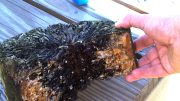


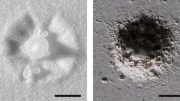

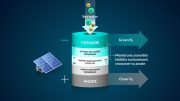


Be the first to comment on "Scientists Create Ideal Pizza Dough That Rises Perfectly Without Yeast"